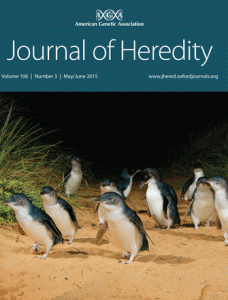
Read the Open Access article here http://jhered.oxfordjournals.org/content/106/3/228.full
A new research project has found that two different groups of Little Penguins have met up to live in a colony together—despite a history of isolation.
Dr Chris Burridge, University of Tasmania Zoology Lecturer, said the motivation of the research was to understand rates of movements of penguins between colonies.
The research was conducted in partnership with the University of Tasmania, Peter Dann (Phillip Island Nature Park), Amanda Peucker (Deakin University) and Craig Styan (University College London).
"The research wanted to find out things like, are individuals from this colony going to another colony to breed? If a colony was wiped out by a predator, would penguins from other colonies come to help replenish it?" Dr Burridge said.
The study took DNA samples from penguins from colonies throughout Australia and cross-checked them against one another.
"If you look at the genes and the frequency of those genes at colonies throughout Australia, you can then work out how much movement there has been of those penguins; when an animal moves between colonies, it takes it's genes with it. This tells us about how the different colonies interact."
Dr Burridge's earlier research found that in South East Australia there was a lot of penguin movement, with penguins moving between colonies all the time. But when research looked closer to Adelaide, suddenly the colonies were very genetically different over a small region.
"There was no clear explanation as to why in South East Australia penguins would move among colonies a lot, then around Kangaroo Island they don't."
The researchers considered factors like oceanographic fronts and the timing of penguin breeding, which varies throughout Australia. But none of these explanations made sense.
By sampling further across to Western Australia, researchers found there were two groups of penguins around Kangaroo Island that had come together and were mixing.
"The results are suggesting the fine spatial genetic structure around Kangaroo Island is the result of two lineages of penguins that have come back together and they're mixing in that part of the world.
"For some reason they became isolated in the east and the west now they're coming back to occupy that central space.
"The interesting question is, why weren't they there before? Why are they suddenly mixing in that part of the world? Maybe it's something to do with climate? It's something we can't readily answer.
"There are some interesting questions there that we haven't addressed yet. For example, do these eastern and western penguins recognise each other in some way?" Dr Burridge said.
"Do they preferentially mate with their own type or another type? We don't have any evidence for that segregation or choice, but need to investigate further."

Check out our herps this issue - our Editor's Choice article by Hogan et al., untangles chemoreceptors in rattlesnakes, while our cover this issue is courtesy of Powell et al., who provide a reference genome for the Australian water dragon

Read all about it here
Apply now for an AGA

This course hosted 25-30 students, especially welcoming to participants from African countries, and 15-20 faculty from around the world. The course featured the latest methods, interpretations, and applications of genetic/genomic analyses for the conservation of endangered species, and the faculty shared their expertise in technologies, research strategies, and translation featuring population-based studies.
https://conservationgenetics.
Read the final report on the conference here to see what you missed!
 This two-day workshop will be part of the 25th Biennial Marine Mammal Conference in Perth this year, accommodating up to 150 experts and novices. It will focus on advancements in marine mammal genomics, highlighting novel methods and applications in evolution, conservation, and emerging diseases, and integrating genomics with traditional knowledge.
This two-day workshop will be part of the 25th Biennial Marine Mammal Conference in Perth this year, accommodating up to 150 experts and novices. It will focus on advancements in marine mammal genomics, highlighting novel methods and applications in evolution, conservation, and emerging diseases, and integrating genomics with traditional knowledge.
https://www.smmconference.org/
Do you want to create interdisciplinary teaching resources for inclusive undergraduate evolution education? The Resources for Inclusive Evolution Education (#RIE2) working group is looking for participants to do just that! Apply now by filling out this google form! Deadline is 5 p.m. PT on May 28, 2024 #ScienceEducation #EvolutionEducation #TeachingEvolution
Please contact inclusive.evoedu@gmail.com
Any questions? Contact the Managing Editor at theaga@theaga.org.